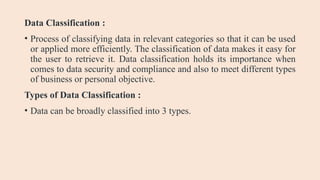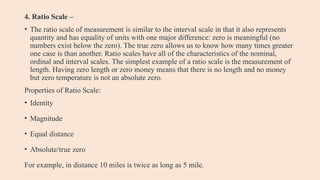Data analytics ŌĆō I: classification of data and measurement scale
- 1. Skill Enhancement Course (SEC) ŌĆō I Data Analytics ŌĆō I Unit ŌĆō I Classification of Data Shambhu Rout Lecturer in Economics Rayagada Autonomous College, Rayagada
- 2. What is Data? ŌĆó Data is a word we hear everywhere nowadays. In general, data is a collection of facts, information, and statistics and this can be in various forms such as numbers, text, sound, images, or any other format. ŌĆ£data is numbers, characters, images, or other method of recording, in a form which can be assessed to make a determination or decision about a specific action.ŌĆØ What is Information? ŌĆó Information is data that has been processed , organized, or structured in a way that makes it meaningful, valuable and useful. It is data that has been given context , relevance and purpose. It gives knowledge, understanding and insights that can be used for decision-making , problem-solving, communication and various other purposes.
- 3. Why data is important ? ŌĆó Data helps in make better decisions. ŌĆó Data helps in solve problems by finding the reason for underperformance. ŌĆó Data helps one to evaluate the performance. ŌĆó Data helps one improve processes. ŌĆó Data helps one understand consumers and the market.
- 4. Data Classification : ŌĆó Process of classifying data in relevant categories so that it can be used or applied more efficiently. The classification of data makes it easy for the user to retrieve it. Data classification holds its importance when comes to data security and compliance and also to meet different types of business or personal objective. Types of Data Classification : ŌĆó Data can be broadly classified into 3 types.
- 5. 1. Structured Data ŌĆó Structured data is created using a fixed schema and is maintained in tabular format. The elements in structured data are addressable for effective analysis. It contains all the data which can be stored in the SQL database in a tabular format. Today, most of the data is developed and processed in the simplest way to manage information. Examples ŌĆō ŌĆó Relational data, Geo-location, credit card numbers, addresses, etc. ŌĆó Consider an example for Relational Data like you have to maintain a record of students for a university like the name of the student, ID of a student, address, and Email of the student. To store the record of students used the following relational schema and table for the same. S_ID S_Name S_Address S_Email 1001 A Delhi A@gmail.com 1002 B Mumbai B@gmail.com
- 6. 2. Unstructured Data ŌĆó It is defined as the data in which is not follow a pre-defined standard or you can say that any does not follow any organized format. This kind of data is also not fit for the relational database because in the relational database you will see a pre-defined manner or you can say organized way of data. Unstructured data is also very important for the big data domain and To manage and store Unstructured data there are many platforms to handle it like No-SQL Database. ŌĆó Examples ŌĆō ŌĆó Word, PDF, text, media logs, etc.
- 7. 3. Semi-Structured Data ŌĆó Semi-structured data is information that does not reside in a relational database but that have some organizational properties that make it easier to analyze. With some process, you can store them in a relational database but is very hard for some kind of semi-structured data, but semi-structured exist to ease space. ŌĆó Example ŌĆō ŌĆó XML data.
- 8. Features of Data Classification : ŌĆó The main goal of the organization of data is to arrange the data in such a form that it becomes fairly available to the users. So, itŌĆÖs basic features as following. ŌĆó Homogeneity ŌĆō The data items in a particular group should be similar to each other. ŌĆó Clarity ŌĆō There must be no confusion in the positioning of any data item in a particular group. ŌĆó Stability ŌĆō The data item set must be stable i.e. any investigation should not affect the same set of classification. ŌĆó Elastic ŌĆō One should be able to change the basis of classification as the purpose of classification changes.
- 9. Types of Data Generally data is of two type - Qualitative and Quantitative ŌĆó Qualitative Data: Data that is represented either in a verbal or narrative format is qualitative data. These types of data are collected through focus groups, interviews, opened ended questionnaire items, and other less structured situations. A simple way to look at qualitative data is to think of qualitative data in the form of words. ŌĆó Quantitative Data: Quantitative data is data that is expressed in numerical terms, in which the numeric values could be large or small. numerical values may correspond to a specific category or label. ŌĆó Mixed Data: Combination of both numerical and categorical data.
- 10. Scale of Measurement Data can be classified as being on one of four scales: nominal, ordinal, interval and ratio. Each level of measurement has some important properties that are useful to know. ’āśProperties of Measurement Scales: ŌĆó Identity ŌĆō Each value on the measurement scale has a unique meaning. ŌĆó Magnitude ŌĆō Values on the measurement scale have an ordered relationship to one another. That is, some values are larger and some are smaller. ŌĆó Equal intervals ŌĆō Scale units along the scale are equal to one another. For Example- the difference between 1 and 2 would be equal to the difference between 11 and 12. ŌĆó A minimum value of zero ŌĆō The scale has a true zero point, below which no values exist.
- 11. 1. Nominal Scale ŌĆō ŌĆó Nominal variables can be placed into categories. These donŌĆÖt have a numeric value and so cannot be added, subtracted, divided or multiplied. These also have no order, and nominal scale of measurement only satisfies the identity property of measurement. ŌĆó For example, gender is an example of a variable that is measured on a nominal scale. Individuals may be classified as ŌĆ£maleŌĆØ or ŌĆ£femaleŌĆØ, but neither value represents more or less ŌĆ£genderŌĆØ than the other.
- 12. 2. Ordinal Scale ŌĆō ŌĆó The ordinal scale contains things that you can place in order. It measures a variable in terms of magnitude, or rank. Ordinal scales tell us relative order, but give us no information regarding differences between the categories. The ordinal scale has the property of both identity and magnitude. ŌĆó For example, in a race If Ram takes first and Vidur takes second place, we do not know competition was close by how many seconds.
- 13. 3. Interval Scale ŌĆō ŌĆó An interval scale has ordered numbers with meaningful divisions, the magnitude between the consecutive intervals are equal. Interval scales do not have a true zero i.e In Celsius 0 degrees does not mean the absence of heat. ŌĆó Interval scales have the properties of: ŌĆó Identity ŌĆó Magnitude ŌĆó Equal distance ŌĆó For example, temperature on Fahrenheit/Celsius thermometer i.e. 90┬░ are hotter than 45┬░ and the difference between 10┬░ and 30┬░ are the same as the difference between 60┬░ degrees and 80┬░.
- 14. 4. Ratio Scale ŌĆō ŌĆó The ratio scale of measurement is similar to the interval scale in that it also represents quantity and has equality of units with one major difference: zero is meaningful (no numbers exist below the zero). The true zero allows us to know how many times greater one case is than another. Ratio scales have all of the characteristics of the nominal, ordinal and interval scales. The simplest example of a ratio scale is the measurement of length. Having zero length or zero money means that there is no length and no money but zero temperature is not an absolute zero. Properties of Ratio Scale: ŌĆó Identity ŌĆó Magnitude ŌĆó Equal distance ŌĆó Absolute/true zero For example, in distance 10 miles is twice as long as 5 mile.
- 15. Thank You






































![2. Numerical Descriptive Measures[1].pdf](https://cdn.slidesharecdn.com/ss_thumbnails/2-241121070922-5ee24598-thumbnail.jpg?width=560&fit=bounds)























